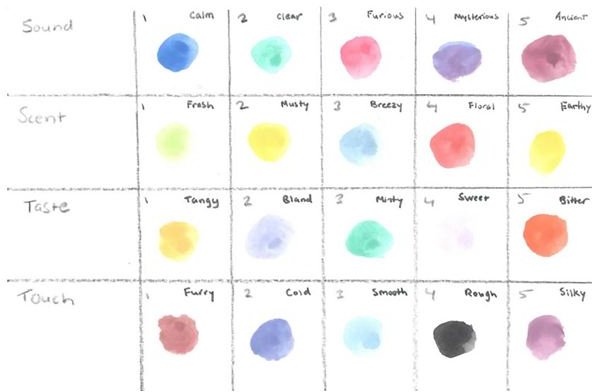Paint with your Senses: Middle School Impressionistic Watercolor Painting
Objective: Students will experience an enhanced painting session using taste, touch, smell, and hearing to connect their senses with color.
Materials: Watercolor paper, masking or painter’s tape, watercolor paints, samples of sounds, tastes, scents, and objects with unique textures, rulers
Note: This lesson may be spread out over several class sessions.
Lesson Procedure:
Introductory Activity: Teacher will post numbered artwork samples featuring a variety of uses of color around the room, and ask students to walk around and write down four sensory adjectives for each piece. When viewing each piece, students should ask themselves what sounds, tastes, textures, or scents each piece evokes as they view it. The teacher will then give students time to share what they wrote down for each piece and see if there are any common reactions among their notes.
Step One: Students will need four pieces of paper (taped to boards), watercolor sets, paintbrushes, and water at their desks. Students need to use their rulers to mark off anywhere from 4-8 sections of their papers (depending on the number of samples the teacher would like to provide for each sense). Label each paper with titles such as “Taste,” “Smell,” Sound,” and “Touch” so that it is clear which sense students are exploring with their colors.
**_
Step Two: Teacher will begin with sense of sound. Using samples of music, instruments, or sound effects, the teacher will play a sample or make a sound while students listen with closed eyes. Students will be asked to visualize colors as they listen to the sounds. After each sound sample, students will open their eyes, immediately select the color they think represents the sound they just heard, and paint a swatch of the color in the corresponding box.
After all of the sound samples have been played, teacher will identify sounds to students (example, number one was ocean waves, number two was a violin, number three was a giggling child, and so on) and ask students to write down an adjective to match the colors they chose for each sound.
Step Three: Teacher will repeat the process with students for each sense, moving on to taste, touch, and scent. Teacher should try to avoid obvious color-sense connections (for example, offering oranges to taste or smell will result in students choosing orange color) as this encourages them to seek a “correct” answer rather than their own unique impressions.
Assessment:
After students have completed color/adjective charts for their sensory samples, the teacher will invite them to choose an adjective from each chart (for a total of four) to create a new painting, which can be representational or abstract. Example: students may choose adjectives such as joyous (sound), floral (scent), rich (taste), springy (touch) to create a painting that shows a spring scene or an abstract painting with colors that expresses that combination of words.
